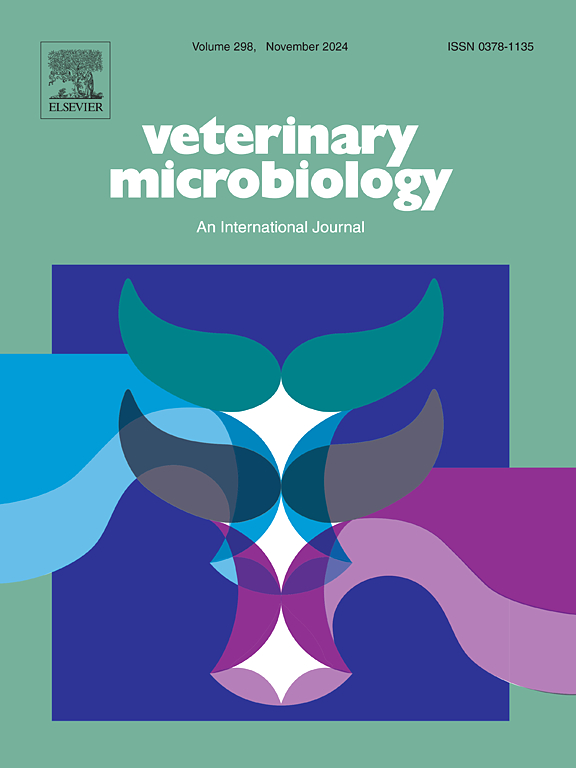The C-terminal nsP1a protein of porcine astrovirus antagonizes interferon beta production by targets MAVS and IRF3 signaling
IF 2.4
2区 农林科学
Q3 MICROBIOLOGY
引用次数: 0
Abstract
Astroviruses (AstV) are positive-sense, single-stranded RNA viruses that can infect humans and a broad spectrum of mammalian and avian species. Recently, Astrovirus strains from various hosts have been implicated in extra-intestinal infections, leading to symptoms such as encephalitis, meningitis, hepatitis, nephropathy and gout. These findings highlight the significant risks associated with its pathogenicity and its potential for interspecies transmission. The astrovirus nsP1a polyprotein is known to produce at least four distinct products. However, the precise demarcation of boundaries for these proteins remains unclear yet. Interferons, along with their antiviral immune responses, have important roles during early stages of viral infection. Viruses typically employ their encoded proteins to evade host-generated immune responses during infections through different mechanisms. In this study, we identified nonstructural proteins of PAstV1 that hinder the type I interferon (IFN) pathway. This was achieved using an IFN-β promoter reporter and by analyzing IFN-β mRNA levels in HEK 293 T cells. Our findings indicate that PAstV1 nsP1a/4 inhibits IFN-β promoter activation mediated via components in the RIG-I-like receptor (RLR) signaling pathway, specifically RIG-I, MDA5, MAVS, and IRF3. Further analyses revealed that PAstV1 nsP1a/4 protein interacts with MAVS and IRF3 to impede the RIG-I/MDA5 signaling and affects their ability to induce IFN. Overall, our results demonstrate that the ectopic expression of PAstV1 nsP1a/4 antagonizes IFN-β production by interacts with MAVS and IRF3. This reveals a novel mechanism by which PAstV nonstructural proteins evade the host’s innate antiviral immune response.
猪星状病毒c端nsP1a蛋白通过靶向MAVS和IRF3信号通路拮抗干扰素β的产生
星状病毒(AstV)是阳性意义的单链RNA病毒,可感染人类和广泛的哺乳动物和鸟类物种。最近,来自不同宿主的星状病毒株与肠外感染有关,导致脑炎、脑膜炎、肝炎、肾病和痛风等症状。这些发现突出了与其致病性和种间传播潜力相关的重大风险。已知星状病毒nsP1a多蛋白至少产生四种不同的产物。然而,这些蛋白质的精确边界划分尚不清楚。干扰素及其抗病毒免疫反应在病毒感染的早期阶段起着重要作用。在感染过程中,病毒通常利用它们的编码蛋白通过不同的机制来逃避宿主产生的免疫反应。在这项研究中,我们发现了阻碍I型干扰素(IFN)途径的PAstV1非结构蛋白。这是通过IFN-β启动子报告子和分析HEK 293 T细胞中IFN-β mRNA水平实现的。我们的研究结果表明,PAstV1 nsP1a/4抑制通过RIG-I样受体(RLR)信号通路中的成分介导的IFN-β启动子激活,特别是RIG-I, MDA5, MAVS和IRF3。进一步分析发现,PAstV1 nsP1a/4蛋白与MAVS和IRF3相互作用,阻断rig - 1 /MDA5信号通路,影响其诱导IFN的能力。总之,我们的研究结果表明,PAstV1 nsP1a/4的异位表达通过与MAVS和IRF3相互作用拮抗IFN-β的产生。这揭示了PAstV非结构蛋白逃避宿主先天抗病毒免疫反应的一种新机制。
本文章由计算机程序翻译,如有差异,请以英文原文为准。
求助全文
约1分钟内获得全文
求助全文
来源期刊

Veterinary microbiology
农林科学-兽医学
CiteScore
5.90
自引率
6.10%
发文量
221
审稿时长
52 days
期刊介绍:
Veterinary Microbiology is concerned with microbial (bacterial, fungal, viral) diseases of domesticated vertebrate animals (livestock, companion animals, fur-bearing animals, game, poultry, fish) that supply food, other useful products or companionship. In addition, Microbial diseases of wild animals living in captivity, or as members of the feral fauna will also be considered if the infections are of interest because of their interrelation with humans (zoonoses) and/or domestic animals. Studies of antimicrobial resistance are also included, provided that the results represent a substantial advance in knowledge. Authors are strongly encouraged to read - prior to submission - the Editorials (''Scope or cope'' and ''Scope or cope II'') published previously in the journal. The Editors reserve the right to suggest submission to another journal for those papers which they feel would be more appropriate for consideration by that journal.
Original research papers of high quality and novelty on aspects of control, host response, molecular biology, pathogenesis, prevention, and treatment of microbial diseases of animals are published. Papers dealing primarily with immunology, epidemiology, molecular biology and antiviral or microbial agents will only be considered if they demonstrate a clear impact on a disease. Papers focusing solely on diagnostic techniques (such as another PCR protocol or ELISA) will not be published - focus should be on a microorganism and not on a particular technique. Papers only reporting microbial sequences, transcriptomics data, or proteomics data will not be considered unless the results represent a substantial advance in knowledge.
Drug trial papers will be considered if they have general application or significance. Papers on the identification of microorganisms will also be considered, but detailed taxonomic studies do not fall within the scope of the journal. Case reports will not be published, unless they have general application or contain novel aspects. Papers of geographically limited interest, which repeat what had been established elsewhere will not be considered. The readership of the journal is global.
 求助内容:
求助内容: 应助结果提醒方式:
应助结果提醒方式:


